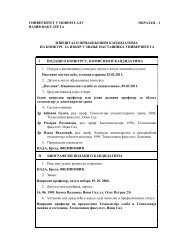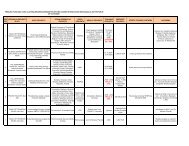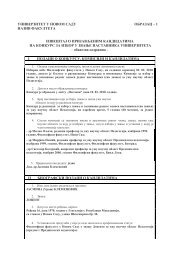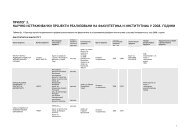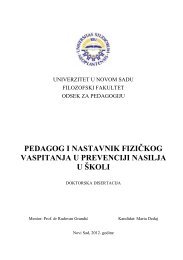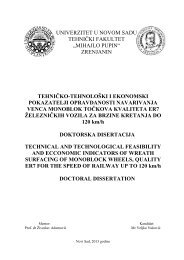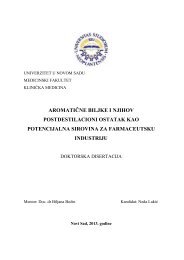Intercultural competence as an aspect of the communicative ...
Intercultural competence as an aspect of the communicative ...
Intercultural competence as an aspect of the communicative ...
You also want an ePaper? Increase the reach of your titles
YUMPU automatically turns print PDFs into web optimized ePapers that Google loves.
h<strong>an</strong>d, <strong>an</strong> inductive approach since a model w<strong>as</strong> built from <strong>the</strong> data. The final model w<strong>as</strong><br />
presented in two forms – a pyramidal model <strong>an</strong>d a process model. Unlike o<strong>the</strong>r models,<br />
this one attempts to represent figuratively a conception <strong>of</strong> foundational elements <strong>an</strong>d <strong>an</strong><br />
implicit ordering <strong>of</strong> elements so that <strong>the</strong> resulting external (visible) outcome is <strong>the</strong><br />
effective <strong>an</strong>d appropriate communication <strong>an</strong>d behaviour in intercultural situations.<br />
2.4.3. Summary<br />
The section presented some <strong>of</strong> <strong>the</strong> models import<strong>an</strong>t for ICC <strong>an</strong>d its inclusion in<br />
teaching, both intercultural <strong>an</strong>d foreign l<strong>an</strong>guage. Different models foreground different<br />
competencies, attitudes or skills, but <strong>the</strong>re is still a lot <strong>of</strong> common ground <strong>an</strong>d repetition<br />
<strong>of</strong> elements. However, <strong>the</strong>re is almost no empirical work in which <strong>the</strong> various models that<br />
have been proposed are compared <strong>an</strong>d tested. As a consequence, a leading <strong>the</strong>ory <strong>of</strong><br />
intercultural <strong>competence</strong> is missing. We are still in this stage <strong>of</strong> conceptual development<br />
in which overlapping, complementary, <strong>an</strong>d incompatible models coexist.<br />
2.5. <strong>Intercultural</strong> <strong>competence</strong> in teaching/ learning context<br />
2.5.1. Introduction<br />
The goals <strong>of</strong> intercultural training, or including intercultural training into l<strong>an</strong>guage<br />
cl<strong>as</strong>ses should be <strong>the</strong> ones that would touch upon cognitive, affective <strong>an</strong>d behavioural<br />
components <strong>of</strong> <strong>the</strong> issue. Both Pusch (1994) <strong>an</strong>d Fowler (1995) agree that students should<br />
have <strong>the</strong> ability to m<strong>an</strong>age psychological barriers, to communicate effectively <strong>an</strong>d to<br />
establish interpersonal relationships. Students should be taught to overcome<br />
psychological barriers <strong>an</strong>d should receive some training on ambiguity, toler<strong>an</strong>ce <strong>an</strong>d<br />
flexibility (Fowler 1995). Also, in order to communicate efficiently, students should have<br />
a sufficient cognitive b<strong>as</strong>e – be aware <strong>of</strong> <strong>the</strong> <strong>communicative</strong> styles <strong>of</strong> all parties involved<br />
in <strong>the</strong> communication, <strong>an</strong>d be flexible. Finally, students should be aware <strong>of</strong> ‘culturally<br />
sensitive ways’ (Fowler 1995: xiii) in which to establish intercultural communication.<br />
In order to achieve <strong>the</strong>se goals, teachers have a wide variety <strong>of</strong> techniques at <strong>the</strong>ir<br />
disposal, m<strong>an</strong>y <strong>of</strong> which are or c<strong>an</strong> be shared with FL teaching. The ones discussed here<br />
are chosen <strong>as</strong> <strong>the</strong> techniques most frequently used in training. They c<strong>an</strong>, <strong>of</strong> course, be<br />
combined <strong>an</strong>d/or slightly altered depending on <strong>the</strong> learners’ pr<strong>of</strong>iles, pr<strong>of</strong>iciency <strong>an</strong>d <strong>the</strong><br />
purposes <strong>of</strong> <strong>the</strong> instruction. The technique explained in more detail is <strong>the</strong> culture<br />
105



